Enabling Green Cellular Networks: A Review and Proposal Leveraging Software-Defined Networking, Network Function Virtualization, and Cloud-Radio Access Network
Abstract
1. Introduction
- A comprehensive review of existing initiatives and research efforts focused on reducing energy consumption in cellular networks.
- The collective contribution of SDN, NFV, and C-RAN to reducing energy consumption in cellular networks.
- Existing challenges and limitations in the convergence of these technologies for energy-efficient communication networks.
- A cellular architecture is proposed based on SDN, NFV, and C-RAN to make the cellular network power efficient.
2. Related Work and Motivation
Motivation
| Literature (Ref.) | Hardware Solutions/ Smart Grid | Renewable Energy Source/ Energy Harvesting | mMIMO | mmWave | HetNet | Cell Zooming | Beamforming | D2D Communication | AI/ML | Sleep Modes Basestation | C-RAN | SDN | NFV |
|---|---|---|---|---|---|---|---|---|---|---|---|---|---|
| Bojkovic et al. [6] | X | X | X | ||||||||||
| Chia et al. [18] | X | ||||||||||||
| Tahsin et al. [20] | X | ||||||||||||
| Alsharif et al. [21] | X | X | |||||||||||
| A. Jahid et al. [22] | X | X | |||||||||||
| A. Jahid et al. [23] | X | ||||||||||||
| M. S. Hossain et al. [24] | X | ||||||||||||
| J. An et al. [25] | X | X | X | ||||||||||
| Z. Hasan et al. [26] | X | X | X | ||||||||||
| Malathy et al. [27] | X | X | X | X | |||||||||
| Ishfaq Bashir Sofi et al. [28] | X | X | X | X | X | ||||||||
| Fatima Salahdine et al. [29] | X | X | X | X | |||||||||
| S. Jamil et al. [30] | X | X | X | ||||||||||
| S. Buzzi et al. [31] | X | X | X | X | X | X | X | ||||||
| B. Mao et al. [32] | X | ||||||||||||
| Sofana Reka et al. [33] | X | ||||||||||||
| F. O. Ehiagwinal et al. [34] | X | X | X | ||||||||||
| Q. Wu et al. [35] | X | X | X | X | |||||||||
| M. Feng et al. [36] | X | X | X | X | |||||||||
| Y. Alsaba et al. [37] | X | X | |||||||||||
| Alsharif et al. [38] | X | ||||||||||||
| U. K. Dutta et al. [39] | X | ||||||||||||
| Nicola Piovesan et al. [40] | X | X | |||||||||||
| S. Guo et al. [41] | X | ||||||||||||
| L. M. P. Larsen et al. [42] | X | ||||||||||||
| L. M. P. Larsen et al. [43] | X | X | X | ||||||||||
| K. N. R. S. V. Prasad et al. [44] | X | X | X | ||||||||||
| Miao Yao et al. [45] | X | ||||||||||||
| Shunging Zhang et al. [46] | X | X | |||||||||||
| A. Bohli et al. [47] | X | X | X | ||||||||||
| M. M. Mowla et al. [48] | X | X | |||||||||||
| S. R. Danve et al. [49] | X | X | X | ||||||||||
| A. Jahid et al. [50] | X | X | |||||||||||
| Alimi et al. [51] | X | X | |||||||||||
| Dawadi et al. [52] | X | ||||||||||||
| Alsharif et al. [53] | X | X | X | X | X | ||||||||
| Usama M et al. [54] | X | X | X | X | |||||||||
| Zhang et al. [55] | X | X | X | X | X | X | |||||||
| Dlamini T. et al. [56] | X | X | X | ||||||||||
| D. A. Temesgene et al. [57] | X | X | X | X | |||||||||
| E. J. Kitindi et al. [58] | X | X | X | ||||||||||
| Chih-Lin I. et al. [59] | X | X | X | X | |||||||||
| This Paper | X | X | X | X | X | X | X | X | X | X | X | X | X |
3. What Is SDN?
3.1. Working Principle
3.1.1. OpenFlow
3.1.2. P4 Language

3.2. Architecture of SDN
- Application Layer: This top layer contains all the applications that need to communicate with the network. These applications can include network topology builders, logging and monitoring tools, network Access Control Lists (ACLs), and other network services [64,70]. The applications are agnostic to the Southbound protocols, whether they use OpenFlow or P4Runtime.
- Control Layer: This central layer houses the SDN controller, which manages the flow of data traffic in the network devices based on the requirements of the application layer. The SDN controller uses Northbound APIs to communicate with the application layer and Southbound APIs to interact with the infrastructure layer [64,70].
- Applications and Services: These programs and systems use the network to communicate and interact with the SDN controller via the Northbound Interface to request network services.
- Northbound Interface: This communication link between the SDN controller and the applications allows applications to request network services and receive network information.
- Network Operating System (NOS): The software running on the SDN controller provides the necessary functionality for managing the network.
- SDN Controller: The heart of the SDN architecture, the SDN controller acts as the network’s “brain”, making packet routing decisions. It interacts with network devices through the Southbound Interface and communicates with applications via the Northbound Interface. Examples of controllers include ONOS, OpenDaylight, Floodlight, IRIS, POX, and Ryu [71].
- Southbound Interface: This communication link between the SDN controller and network devices transmits instructions from the controller to the devices and provides the controller with network state information.
- Network Devices: The physical infrastructure, including switches, routers, and other networking hardware, receives instructions from the SDN controller and forwards or drops data packets accordingly.
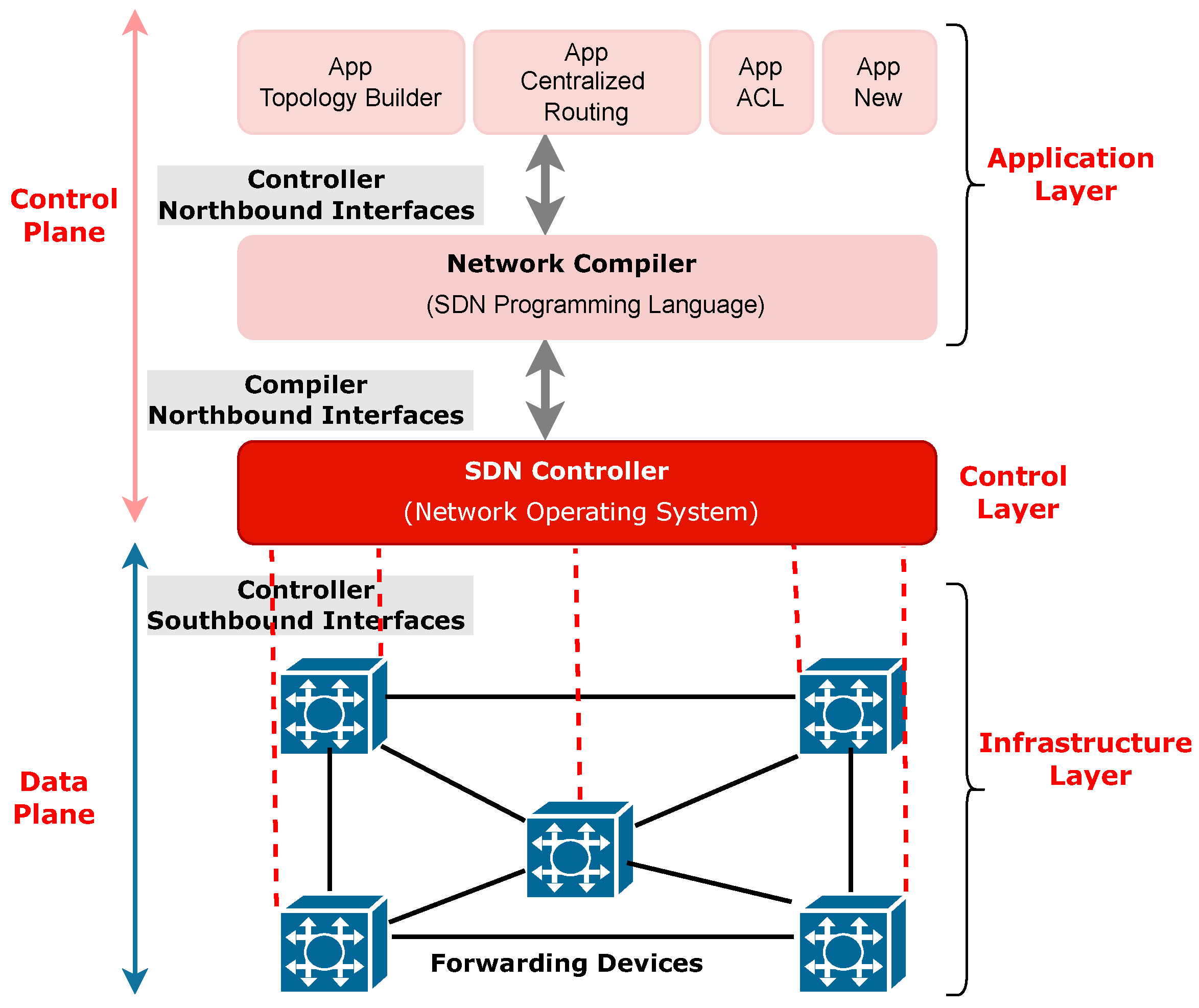
3.3. How SDN Will Help Cellular Network 5G and Beyond
3.4. Challenges and Solutions
4. What Is NFV?
4.1. Working Principle of NFV
4.2. Architecture of NFV
- Virtualized Network Functions (VNFs): VNFs are the virtual instances of network functions implemented as software-based functions that were traditionally implemented using dedicated hardware. Network functions such as routing, firewall, and network optimization can be implemented using software and deployed and managed on the data centers or in the cloud.
- NFV Infrastructure (NFVI): NFVI is responsible for providing the underlying physical and virtual infrastructure for hosting the VNFs. It includes the following elements:
- (a)
- Compute Resources: NFVI provides general-purpose servers or cloud-based compute instances where VNFs run.
- (b)
- Network and Storage Resources: NFVI uses virtualized network components like connectivity, switches, routers, VLANs, and storage (including cloud storage) to handle data and configurations. These resources form the backbone for managing information within NFVI.
- (c)
- Virtualization Layer: The virtualization layer is responsible for providing virtualization technologies, such as hypervisors and containerization, to run VNFs on available physical hardware.
- Element Management System (EMS): This manages the physical network equipment, including legacy hardware, which is used for the deployment of NFV. It ensures coordination between virtualized and traditional network elements.
- Operations Support System (OSS) and Business Support System (BSS): These systems provide end-to-end network service management, billing, and provisioning.
- MANO: Management and orchestration in network function virtualization, is divided into three key functional blocks:
- (a)
- NFV Orchestrator (NFVO): The NFVO is responsible for VNF lifecycle management, handling deployment and scaling coordination. It integrates with NFVI to provide the required resources and communicate with the VNF Manager (VNFM) for VNF-specific tasks.
- (b)
- VNF Manager (VNFM): VNFM manages the lifecycle of VNFs, which includes instantiation, configuration, and termination (on/off) of VNFs. VNF Manager communicates with NFVO and VNF itself to manage the functionality of VNFs.
- (c)
- Virtualized Infrastructure Manager (VIM): VIM manages the virtual resources required for VNFs. It identifies, allocates, and handles faults in physical and virtual resources.
4.3. How NFV Will Help Cellular Network

4.4. Challenges and Solutions
4.4.1. Core: Challenges and Solutions
4.4.2. RAN: Challenges and Solutions
5. What Is C-RAN?
5.1. Working Principle of C-RAN
5.2. Architecture of C-RAN
5.3. How Can C-RAN Improve the Sustainability of Cellular Networks?
5.4. Challenges and Solutions
6. Pitfalls and Potentials
- Interoperability and Standardization: Different vendors may implement the supporting hardware and software related to SDN, NFV, and C-RAN technologies using their proprietary protocols and interfaces, resulting in interoperability issues. To avoid the interoperability issue, there should be a strong collaboration between the different stakeholders. The telecom industry should promote organizations like ONF [64] and ETSI [121] that support the standardization of these tools and technologies [122].
- Scalability: As telecom networks expand in size to support the increasing demand for connectivity raises the complexity of the network and leads to scalability issues related to SDN, NFV, and C-RAN. Dynamic scaling mechanisms can be implemented to solve the scalability issues. Technologies like orchestration can also be employed to handle the scalability issue [123].
- Network Performance and Latency: Introducing the virtualization and centralization control of network functions may increase the latency and affect real-time applications, for instance, voice and video streaming. To mitigate latency issues, SDN- and NFV-based edge computing capabilities can be deployed near the end-users. The use of efficient routing algorithms and optimization of network architecture can also minimize latency [124].
- Management and Orchestration: It can be challenging to manage and orchestrate virtualized network functions across distributed environments. Utilizing comprehensive management and orchestration platforms can provide centralized control and automation capabilities to ease network operations. These platforms also support multi-vendor environments [125].
- Resource Utilization and Optimization: Amplifying resource utilization in virtualized environments, whether it is computing, storage, or networking, is crucial for achieving cost-effectiveness. Utilizing intelligent resource allocation algorithms and analytics-driven optimization techniques can help optimize resource utilization. Furthermore, network-slicing technologies can facilitate efficient resource allocation for specific applications [126].
- Regulatory and Compliance Issues: Ensuring compliance with regulatory requirements and standards during the implementation of SDN, NFV, and C-RAN solutions introduces some challenges due to the dynamic nature of virtualized networks. It is crucial to be updated with the new rules and regulations set by the regulatory bodies. It is also important to utilize features such as network segmentation and encryption to protect data and avoid compliance issues [127].
6.1. Reducing the Energy Consumption
6.2. Virtualization Feasibility of Network Functions
6.2.1. Core Functions Easy for Virtualization
6.2.2. Core Functions Complex for Virtualization
6.2.3. Virtualization of RAN Functions
7. Proposed Architecture for Cellular System Based on SDN, NFV, and C-RAN
- 5G Core Control Plane With Virtualized Core Functions: The core of the 5G and beyond cellular network can be fully virtualized since flexibility is more important for operators to support different use cases. Virtualization of the core will help to develop quicker solutions/applications, and the developed solutions can be deployed and tested faster. It could also pave the way for more innovative and flexible network services, as network operators would have more freedom to customize and optimize their networks based on a single, unified platform [97].From an energy-efficiency perspective, virtualizing the 5G core delivers three significant benefits. First, hardware consolidation replaces dedicated appliances with virtualized functions, reducing power consumption by up to 40% through improved resource utilization [93]. Second, dynamic scaling enables core functions like UDM and AUSF to automatically adjust resources based on demand, eliminating energy waste during low-traffic periods. Third, by concentrating virtual resources in data centers rather than in distributed hardware, operators achieve 35% savings in cooling costs through optimized thermal management [95].
- SDN Controller: The SDN controller oversees the entire network element and manages the resource allocation based on the demands. This is a central point that manages the data flow in the network through SDN principles, making the network programmable and more adaptable to varying traffic patterns and demands [97]. The SDN controller serves as the centralized intelligence for network-wide resource management, directly addressing the critical energy efficiency challenges identified in Section 6. By dynamically scaling resources to match real-time traffic patterns, it eliminates energy waste from over-provisioning, reducing idle power consumption compared to static architectures through optimal VNF placement [93]. The controller’s global network view enables intelligent traffic routing that minimizes transmission hops, cutting routing energy while maintaining QoS requirements.
- Backhaul and Fronthaul Link: Fiber optic cables and microwave links are two options for the backhaul connections that link the core network to the RAN architecture. Fiber optic cables are more energy efficient under heavy load conditions, while microwave links are better under low load conditions [48]. Fronthaul connects the BBUs in the C-RAN architecture to RRUs on cell towers, typically using high-bandwidth, low-latency connections such as fiber cables.
- Cloud vRAN: The elements of C-RAN could also be virtualized to curtail the use of energy. The C-RAN elements are given below:
- –
- BBU: Processes the baseband signal and is part of the C-RAN that can be centralized in a data center to serve multiple radio sites.
- –
- PHY (Physical Layer): The layer in the BBU that handles the physical connection to the network.
- –
- MAC/RLC: These layers manage multiple access protocols and data transfer reliability.
- –
- RRC/PDCP: These layers manage radio resources and the convergence of data from different sources.
- NFV in C-RAN: When NFV and C-RAN are combined, they offer more energy-efficient, flexible, and scalable cellular networks. In C-RAN, functions with stringent latency requirements, such as Digital Signal Processing (DSP), are deployed on the dedicated hardware and co-located with RRHs. On the other hand, BBU functionalities such as packet scheduling and user management could be virtualized since these functions are not as latency sensitive and could be decoupled from hardware and deployed as software instance [95].
- User Equipment and Applications: This represents the devices and applications that use the cellular network, such as smartphones, wearables, and vehicles.
7.1. Interaction Between SDN Controller, NFV MANO, and C-RAN
- C-RAN Management:
- –
- Centralization: The SDN controller can centralize the control of the C-RAN infrastructure, allowing for the pooling of BBUs that can be dynamically assigned to RRUs based on the current network load and demand.
- –
- Network Optimization: Through the SDN controller, the network can optimize the routing of traffic between the RRUs and BBUs. It can also manage the split of control and user plane functions to improve performance and efficiency.
- –
- Dynamic Configuration: The SDN controller enables the dynamic reconfiguration of network resources in response to changing traffic patterns. This will help C-RAN to allocate and reallocate radio resources in real-time.
- NFV Management:
- –
- Oversees the Underlying Network Infrastructure: In the proposed architecture, the SDN controller does not directly handle the core network functions. Instead, it oversees the underlying network infrastructure. This infrastructure allows various network functions such as signaling, session management, and authentication to communicate with each other and with the radio access network. The SDN controller ensures that the data plane where actual data flows aligns smoothly with the control plane where decisions are made, resulting in an efficient and agile network [104].
- –
- Interconnectivity: Figure 18 shows the layered architecture of the integration of SDN and NFV systems. It is similar to SDN architecture and consists of infrastructure, control, and application layers. It utilizes the principle of NFV to facilitate the implementation and management of network functions. The SDN controller orchestrates network resources to ensure proper communication among VNFs. Under the management of the VIM, the controller can modify network behavior as required, responding to network user requests [97]. The SDN controller and NFV MANO work together to improve network services. SDN enhances NFV by providing better traffic steering and service chaining. MANO is responsible for managing and orchestrating the virtual network resources and connections between VNFs for a complete network service. This requires the SDN controller and MANO to collaborate for efficient traffic routing [104].
- –
- Deployment and Orchestration: The SDN controller, in collaboration with NFV orchestration tools, can deploy and manage the lifecycle of VNFs, such as scaling out or in, based on the network’s requirements. As depicted in Figure 19, the network orchestration function is utilized to establish network service chaining policies. These policies are also shared with the SDN controller within the NFVI networking layer through the NFV MANO framework. This collaboration provides efficient traffic routing and enhances overall network services [104].
- –
- Policy Enforcement: The SDN controller can enforce network policies at a granular level, directing specific types of traffic to pass through certain VNFs for processing, such as firewalls and load balancers.
- Integration of SDN with C-RAN and VNF:
- –
- Flexibility and Scalability: By integrating SDN with C-RAN and VNFs, the network gains flexibility and scalability, allowing it to support a wide range of services and adapt to changes in traffic patterns or network conditions.
- –
- Resource Utilization: The SDN controller enhances resource utilization by matching computing and radio resources with network demands in real-time, which is critical for the efficiency of both C-RANs and VNFs.
7.2. Supporting Organization
8. Conclusions
- Quantitative validation: Simulations or testbed implementations should be conducted to evaluate the real-world energy efficiency of the proposed architectures under diverse traffic conditions.
- AI-driven optimization: Machine-learning techniques should be employed to enhance SDN/NFV orchestration, enabling more intelligent resource management.
- Standardization efforts: Interoperability gaps, particularly in Open RAN and hybrid cloud-edge deployments, should be addressed to facilitate seamless integration.
- 6G integration: The convergence with emerging technologies, such as terahertz communication and quantum networking, should be explored to further advance sustainability goals.
Author Contributions
Funding
Acknowledgments
Conflicts of Interest
References
- Mobile Data Traffic Outlook. Available online: https://www.ericsson.com/en/reports-and-papers/mobility-report/dataforecasts/mobile-traffic-forecast (accessed on 12 February 2025).
- What’s the Real Story Behind the Explosive Growth of Data? Available online: https://www.red-gate.com/blog/database-development/whats-the-real-story-behind-the-explosive-growth-of-data (accessed on 10 February 2025).
- What’s Causing the Exponential Growth of Data? Available online: https://insights.nikkoam.com/articles/2019/12/whats_causing_the_exponential (accessed on 4 February 2025).
- This Is How Much Data We’re Using on Our Phones. Available online: https://www.weforum.org/agenda/2021/08/how-the-pandemic-sparked-a-data-boom/ (accessed on 2 February 2025).
- Ericsson and SDGs: Partnership for the Future. Available online: https://www.ericsson.com/en/blog/2023/9/ericsson-sdgs-partnership-for-the-future (accessed on 15 February 2025).
- Bojkovic, Z.S.; Milovanovic, D.A.; Fowdur, T.P. (Eds.) 5G Multimedia Communication: Technology, Multiservices, and Deployment, 1st ed.; CRC Press: Boca Raton, FL, USA, 2020. [Google Scholar] [CrossRef]
- Ensure Efficient Energy Consumption of 5G Core. Available online: https://www.nokia.com/about-us/news/releases/2024/02/21/nokia-utilizes-intel-technology-to-drive-greater-5g-network-energy-savings-through-software-innovations-and-new-chips-mwc24/ (accessed on 2 April 2025).
- Ahmed, Z.E.; Saeed, R.A.; Mukherjee, A. Challenges and Opportunities in Vehicular Cloud Computing. In Cloud Security: Concepts, Methodologies, Tools, and Applications; Management Association, Information Resources, Eds.; IGI Global: Hershey, PA, USA, 2019; pp. 2168–2185. [Google Scholar] [CrossRef]
- Dursch, A.; Yen, D.C.; Huang, S.M. Fourth generation wireless communications: An analysis of future potential and implementation. Comput. Stand. Interfaces 2005, 28, 13–25. [Google Scholar] [CrossRef]
- Bai, F.; Elbatt, T.; Hollan, G.; Krishnan, H.; Sadekar, V. Towards characterizing and classifying communication-based automotive applications from a wireless networking perspective. In Proceedings of the IEEE Workshop on Automotive Networking and Applications (AutoNet), San Francisco, CA, USA, 27 November–1 December 2006; pp. 1–25. [Google Scholar]
- Chuanmin, C.; Feng, W. Evolution of the telecommunications industry, a natural monopoly attributed from the U.S. telecommunications industry. Financ. Econ. 2012, 10, 70–72. [Google Scholar]
- Dagnaw, G.A. The Intelligent Six Generation Networks for Green Communication Environment; Department of Information Science, Faculty of Informatics, University of Gondar: Gondar, Ethiopia, 2020. [Google Scholar]
- Saeed, M.; Saeed, R.A.; Saeid, E. Identity Division Multiplexing Based Location Preserve in 5G. In Proceedings of the 2021 IEEE International Conference of Technology, Science and Administration (ICTSA), Taiz, Yemen, 22–24 March 2021. [Google Scholar] [CrossRef]
- Zhang, Y. SDN and NFV in 5G. In Network Function Virtualization: Concepts and Applicability in 5G Networks; Wiley: Hoboken, NJ, USA, 2018; pp. 109–146. [Google Scholar] [CrossRef]
- Fondo-Ferreiro, P.; Gil-Castiñeira, F. The Role of Software-Defined Networking in Cellular Networks. Proceedings 2019, 21, 23. [Google Scholar] [CrossRef]
- Software-Defined Networking (SDN) Definition. Available online: https://opennetworking.org/sdn-definition/ (accessed on 19 February 2025).
- Network Functions Virtualisation–Introductory White Paper. Available online: https://portal.etsi.org/nfv/nfv_white_paper.pdf (accessed on 14 February 2025).
- Chia, Y.K.; Sun, S.; Zhang, R. Energy Cooperation in Cellular Networks with Renewable Powered Base Stations. IEEE Trans. Wirel. Commun. 2013, 13, 6996–7010. [Google Scholar] [CrossRef]
- HOMER Microgrid and Hybrid Power Modeling Software. Available online: https://www.ul.com/software/homer-microgrid-and-hybrid-power-modeling-software (accessed on 20 February 2025).
- Tahsin, A.; Roy, P.; Razzaque, M.A.; Mamun-Or-Rashid, M.; Siraj, M.; AlQahtani, S.A.; Hassan, M.R.; Hassan, M.M. Energy Cooperation Among Sustainable Base Stations in Multi-Operator Cellular Networks. IEEE Access 2023, 11, 19405–19417. [Google Scholar]
- Alsharif, M.H.; Kim, J.; Kim, J.H. Green and Sustainable Cellular Base Stations: An Overview and Future Research Directions. Energies 2017, 10, 587. [Google Scholar] [CrossRef]
- Jahid, A.; Hossain, S. Intelligent Energy Cooperation Framework for Green Cellular Base Stations. In Proceedings of the 2018 International Conference on Computer, Communication, Chemical, Material and Electronic Engineering (IC4ME2), Rajshahi, Bangladesh, 8–9 February 2018; pp. 1–6. [Google Scholar] [CrossRef]
- Jahid, A.; Monju, M.K.H.; Hossain, M.E.; Hossain, M.F. Renewable Energy Assisted Cost Aware Sustainable Off-Grid Base Stations With Energy Cooperation. IEEE Access 2018, 6, 60900–60920. [Google Scholar] [CrossRef]
- Hossain, M.S.; Jahid, A.; Islam, K.Z.; Rahman, M.F. Solar PV and Biomass Resources-Based Sustainable Energy Supply for Off-Grid Cellular Base Stations. IEEE Access 2020, 8, 53817–53840. [Google Scholar] [CrossRef]
- An, J.; Yang, K.; Wu, J.; Ye, N.; Guo, S.; Liao, Z. Achieving Sustainable Ultra-Dense Heterogeneous Networks for 5G. IEEE Commun. Mag. 2017, 55, 84–90. [Google Scholar] [CrossRef]
- Hasan, Z.; Boostanimehr, H.; Bhargava, V.K. Green Cellular Networks: A Survey, Some Research Issues and Challenges. IEEE Commun. Surv. Tutor. 2011, 13, 524–540. [Google Scholar] [CrossRef]
- Malathy, S.; Jayarajan, P.; Ojukwu, H.; Qamar, F.; Hindia, M.N.; Dimyati, K.; Noordin, K.A.; Amiri, I.S. A review on energy management issues for future 5G and beyond network. Wirel. Netw 2021, 27, 2691–2718. [Google Scholar] [CrossRef]
- Sofi, I.B.; Gupta, A. A survey on energy efficient 5G green network with a planned multi-tier architecture. J. Netw. Comput. Appl. 2018, 118, 1–28. [Google Scholar] [CrossRef]
- Salahdine, F.; Opadere, J.; Liu, Q.; Han, T.; Zhang, N.; Wu, S. A survey on sleep mode techniques for ultra-dense networks in 5G and beyond. Comput. Netw. 2021, 2021, 108567. [Google Scholar] [CrossRef]
- Jamil, S.; Fawad; Abbas, M.S.; Umair, M.; Hussain, Y. A Review of Techniques and Challenges in Green Communication. In Proceedings of the 2020 International Conference on Information Science and Communication Technology (ICISCT), Karachi, Pakistan, 8–9 February 2020; pp. 1–6. [Google Scholar] [CrossRef]
- Buzzi, S.; Klein, C.-L.I.T.E.; Poor, H.V.; Yang, C.; Zappone, A. A Survey of Energy-Efficient Techniques for 5G Networks and Challenges Ahead. IEEE J. Sel. Areas Commun. 2016, 34, 697–709. [Google Scholar] [CrossRef]
- Mao, B.; Tang, F.; Kawamoto, Y.; Kato, N. AI Models for Green Communications Towards 6G. IEEE Commun. Surv. Tutor. 2022, 24, 210–247. [Google Scholar] [CrossRef]
- S, S.R.; Dragičević, T.; Siano, P.; Prabaharan, S.R.S. Future Generation 5G Wireless Networks for Smart Grid: A Comprehensive Review. Energies 2019, 12, 2140. [Google Scholar] [CrossRef]
- Ehiagwina1, F.O.; Kehinde1, O.O.; Adewale, A.A.; Seluwa1, O.E.; Anifowose, J.J. An Insight into Deployments of Green Base Stations (GBSs) for an Environmentally Sustainable World. Published under licence by IOP Publishing Ltd, IOP Conference Series: Materials Science and Engineering. In Proceedings of the Nternational Conference on Engineering for Sustainable World (ICESW 2020), Ota, Nigeria, 10–14 August 2020; Volume 1107. [Google Scholar]
- Wu, Q.; Li, G.Y.; Chen, W.; Ng, D.W.K.; Schober, R. An Overview of Sustainable Green 5G Networks. IEEE Wirel. Commun. 2017, 24, 72–80. [Google Scholar] [CrossRef]
- Feng, M.; Mao, S.; Jiang, T. Base Station ON-OFF Switching in 5G Wireless Networks: Approaches and Challenges. IEEE Wirel. Commun. 2017, 24, 46–54. [Google Scholar] [CrossRef]
- Alsaba, Y.; Rahim, S.K.A.; Leow, C.Y. Beamforming in Wireless Energy Harvesting Communications Systems: A Survey. IEEE Commun. Surv. Tutor. 2018, 20, 1329–1360. [Google Scholar] [CrossRef]
- Alsharif, M.H.; Kelechi, A.H.; Kim, J.; Kim, J.H. Energy Efficiency and Coverage Trade-Off in 5G for Eco-Friendly and Sustainable Cellular Networks. Symmetry 2019, 11, 408. [Google Scholar] [CrossRef]
- Dutta, K.; Razzaque, M.A.; Al-Wadud, M.A.; Islam, M.S.; Hossain, M.S.; Gupta, B.B. Self-Adaptive Scheduling of Base Transceiver Stations in Green 5G Networks. IEEE Access 2018, 6, 7958–7969. [Google Scholar] [CrossRef]
- Piovesan, N.; Gambin, A.F.; Miozzo, M.; Rossi, M.; Dini, P. Energy sustainable paradigms and methods for future mobile networks: A survey. Comput. Commun. 2018, 119, 101–117. [Google Scholar] [CrossRef]
- Guo, S.; Zeng, D.; Gu, L. Green C-RAN: A Joint Approach to the Design and Energy Optimization. In Proceedings of the 2017 IEEE 86th Vehicular Technology Conference (VTC-Fall), Toronto, ON, Canada, 24–27 September 2017; pp. 1–5. [Google Scholar] [CrossRef]
- Larsen, L.M.P.; Ruepp, S.; Berger, M.S.; Christiansen, H.L. Energy Consumption Modelling of Next Generation Mobile Crosshaul Networks. In Proceedings of the 2021 IEEE International Conferences on Internet of Things (iThings) and IEEE Green Computing & Communications (GreenCom) and IEEE Cyber, Physical & Social Computing (CPSCom) and IEEE Smart Data (SmartData) and IEEE Congress on Cybermatics (Cybermatics), Melbourne, Australia, 6–8 December 2021; pp. 153–160. [Google Scholar] [CrossRef]
- Larsen, L.M.P.; Christiansen, H.L.; Ruepp, S.; Berger, M.S. Toward Greener 5G and Beyond Radio Access Networks—A Survey. IEEE Open J. Commun. Soc. 2023, 4, 768–797. [Google Scholar] [CrossRef]
- Prasad, K.N.R.S.V.; Hossain, E.; Bhargava, V.K. Energy Efficiency in Massive MIMO-Based 5G Networks: Opportunities and Challenges. IEEE Wirel. Commun. 2017, 24, 86–94. [Google Scholar] [CrossRef]
- Yao, M.; Sohul, M.M.; Ma, X.; Marojevic, V.; Reed, J.H. Sustainable green networking: Exploiting degrees of freedom towards energy-efficient 5G systems. Wirel. Netw. 2019, 25, 951–960. [Google Scholar] [CrossRef]
- Zhang, S.; Wu, Q.; Xu, S.; Li, G.Y. Fundamental Green Tradeoffs: Progresses, Challenges, and Impacts on 5G Networks. Commun. Surv. Tuts. 2017, 19, 33–56. [Google Scholar] [CrossRef]
- Bohli, A.; Bouallegue, R. How to Meet Increased Capacities by Future Green 5G Networks: A Survey. IEEE Access 2019, 7, 42220–42237. [Google Scholar] [CrossRef]
- Mowla, M.M.; Ahmad, I.; Habibi, D.; Phung, Q.V. Energy Efficient Backhauling for 5G Small Cell Networks. IEEE Trans. Sustain. Comput. 2019, 4, 279–292. [Google Scholar] [CrossRef]
- Danve, S.R.; Nagmode, M.S.; Deosarkar, S.B. Energy Efficient Cellular Network Base Station: A Survey. In Proceedings of the 2019 IEEE Pune Section International Conference (PuneCon), Pune, India, 18–20 December 2019; pp. 1–4. [Google Scholar] [CrossRef]
- Jahid, A.; Alsharif, M.H.; Uthansakul, P.; Nebhen, J.; Aly, A.A. Energy Efficient Throughput Aware Traffic Load Balancing in Green Cellular Networks. IEEE Access 2021, 9, 90587–90602. [Google Scholar] [CrossRef]
- Alimi, I.A.; Abdalla, A.M.; Olapade Mufutau, A.; Pereira Guiomar, F.; Otung, I.; Rodriguez, J.; Pereira Monteiro, P.; Teixeira, A.L. Energy Efficiency in the Cloud Radio Access Network (C-RAN) for 5G Mobile Networks. In Optical and Wireless Convergence for 5G Networks; Abdalla, A.M., Rodriguez, J., Elfergani, I., Teixeira, A., Eds.; Wiley Online Library: Hoboken, NJ, USA, 2019. [Google Scholar] [CrossRef]
- Dawadi, B.R.; Rawat, D.B.; Joshi, S.R.; Keitsch, M.M. Towards energy efficiency and green network infrastructure deployment in Nepal using software defined IPv6 network paradigm. Electr. J. Inf. Syst. Dev. Countr. 2020, 86, e12114. [Google Scholar] [CrossRef]
- Alsharif, M.H.; Nordin, R.; Abdullah, N.F.; Kelechi, A.H. How to make key 5G wireless technologies environmental friendly: A review. Trans. Emerg. Tel. Tech. 2018, 29, e3254. [Google Scholar] [CrossRef]
- Usama, M.; Erol-Kantarci, M. A Survey on Recent Trends and Open Issues in Energy Efficiency of 5G. Sensors 2019, 19, 3126. [Google Scholar] [CrossRef] [PubMed] [PubMed Central]
- Zhang, S.; Cai, X.; Zhou, W.; Wang, Y. Green 5G enabling technologies: An overview. IET Commun. 2019, 13, 135–143. [Google Scholar] [CrossRef]
- Thembelihle, D.; Rossi, M.; Munaretto, D. Softwarization of Mobile Network Functions towards Agile and Energy Efficient 5G Architectures: A Survey. Wirel. Commun. Mob. Comput. 2017, 2017, 8618364. [Google Scholar] [CrossRef]
- Temesgene, D.A.; Nuñez-Martinez, J.; Dini, P. Softwarization and Optimization for Sustainable Future Mobile Networks: A Survey. IEEE Access 2017, 5, 25421–25436. [Google Scholar] [CrossRef]
- Kitindi, E.J.; Fu, S.; Jia, Y.; Kabir, A.; Wang, Y. Wireless Network Virtualization With SDN and C-RAN for 5G Networks: Requirements, Opportunities, and Challenges. IEEE Access 2017, 5, 19099–19115. [Google Scholar] [CrossRef]
- Chih-Lin, I.; Han, S.; Xu, Z.; Sun, Q.; Pan, Z. 5G: Rethink mobile communications for 2020+Phil. Trans. R. Soc. A 2016, 374, 20140432. [Google Scholar]
- Waseem, Q.; Din, W.I.S.W.; Aminuddin, A.; Mohammed, M.H.; Aziza, R.F.A. Software-Defined Networking (SDN): A Review. In Proceedings of the 2022 5th International Conference on Information and Communications Technology (ICOIACT), Yogyakarta, Indonesia, 24–25 August 2022; pp. 30–35. [Google Scholar] [CrossRef]
- Mousa, M.; Bahaa-Eldin, A.M.; Sobh, M. Software Defined Networking concepts and challenges. In Proceedings of the 2016 11th International Conference on Computer Engineering & Systems (ICCES), Cairo, Egypt, 20–21 December 2016; pp. 79–90. [Google Scholar] [CrossRef]
- Kreutz, D.; Ramos, F.M.V.; Veríssimo, P.E.; Rothenberg, C.E.; Azodolmolky, S.; Uhlig, S. Software-Defined Networking: A Comprehensive Survey. Proc. IEEE 2015, 103, 14–76. [Google Scholar] [CrossRef]
- Ahmad, S.; Mir, A. Securing centralized sdn control with distributed blockchain technology. Comput. Sci. 2023, 24. [Google Scholar] [CrossRef]
- ONF. Available online: https://opennetworking.org/ (accessed on 26 January 2025).
- Göransson, P.; Black, C.; Culver, T. The OpenFlow Specification. In Software Defined Networks; Elsevier: Amsterdam, The Netherlands, 2017; pp. 89–136. [Google Scholar]
- Bosshart, P.; Daly, D.; Gibb, G.; Izzard, M.; McKeown, N.; Rexford, J.; Schlesinger, C.; Talayco, D.; Vahdat, A.; Varghese, G.; et al. P4: Programming protocol-independent packet processors. SIGCOMM Comput. Commun. Rev. 2014, 44, 87–95. [Google Scholar] [CrossRef]
- P4 Specification. Available online: https://github.com/p4lang/p4-spec/releases (accessed on 2 February 2025).
- P416 Language Specification. Available online: https://p4.org/p4-spec/docs/P4-16-v1.2.2.html (accessed on 3 February 2025).
- Liatifis, A.; Sarigiannidis, P.; Argyriou, V.; Lagkas, T. Advancing SDN from OpenFlow to P4: A Survey. ACM Comput. Surv. 2023, 55, 186. [Google Scholar]
- Haleplidis, E.; Networks, M. Overview of RFC7426: SDN Layers and Architecture. IEEE Softwarization, Canada, September 2017. Available online: https://sdn.ieee.org/newsletter/september-2017/overview-of-rfc7426-sdn-layers-and-architecture-terminology (accessed on 26 January 2025).
- Shirvar, A.; Goswami, B. Performance Comparison of Software-Defined Network Controllers. In Proceedings of the 2021 International Conference on Advances in Electrical, Computing, Communication and Sustainable Technologies (ICAECT), Bhilai, India, 19–20 February 2021; pp. 1–13. [Google Scholar] [CrossRef]
- Singh, R. Reliable and Secure M2M/IoT Communication Engineering: Control, Management, and Benchmarking, Department of Electrical and Photonics Engineering Networks Technology and Service Platforms. Ph.D. Thesis, Technical University of Denmark, Kongens Lyngby, Denmark, 2024. [Google Scholar]
- Gharbaoui, M.; Contoli, C.; Davoli, G.; Cuffaro, G.; Martini, B.; Paganelli, F.; Cerroni, W.; Cappanera, P.; Castoldi, P. Demonstration of Latency-Aware and Self-Adaptive Service Chaining in 5G/SDN/NFV infrastructures. In Proceedings of the 2018 IEEE Conference on Network Function Virtualization and Software Defined Networks (NFV-SDN), Verona, Italy, 27–29 November 2018; pp. 1–2. [Google Scholar] [CrossRef]
- Overview. Available online: https://www.infosys.com/services/engineering-services/service-offerings/sdn-5g-overview.html (accessed on 26 January 2025).
- Syed-Yusof, S.K.; Numan, P.E.; Yusof, K.M.; Din, J.B.; Marsono, M.N.B.; Onumanyi, A.J. Software-Defined Networking (SDN) and 5G Network: The Role of Controller Placement for Scalable Control Plane. In Proceedings of the 2020 IEEE International RF and Microwave Conference (RFM), Kuala Lumpur, Malaysia, 14–16 December 2020; pp. 1–6. [Google Scholar] [CrossRef]
- Tayyaba, S.K.; Shah, M.A. 5G cellular network integration with SDN: Challenges, issues and beyond. In Proceedings of the 2017 International Conference on Communication, Computing and Digital Systems (C-CODE), Islamabad, Pakistan, 8–9 March 2017; pp. 48–53. [Google Scholar] [CrossRef]
- Prados-Garzon, J.; Adamuz-Hinojosa, O.; Ameigeiras, P.; Ramos-Munoz, J.; Andres-Maldonado, P.; Lopez-Soler, J. Handover implementation in a 5G SDN-based mobile network architecture. In Proceedings of the 2016 IEEE 27th Annual International Symposium On Personal, Indoor, And Mobile Radio Communications (PIMRC), Valencia, Spain, 4–7 September 2016; pp. 1–6. [Google Scholar]
- Ameigeiras, P.; Ramos-munoz, J.; Schumacher, L.; Prados-Garzon, J.; Navarro-Ortiz, J.; Lopez-soler, J. Link-level access cloud architecture design based on SDN for 5G networks. IEEE Netw. 2015, 29, 24–31. [Google Scholar]
- Guerzoni, R.; Trivisonno, R.; Soldani, D. SDN-Based Architecture and Procedures for 5G Networks. In Proceedings of the 2014 1st International Conference on 5G for Ubiquitous Connectivity, 5GU 2014, Akaslompolo, Finland, 26–28 November 2014. [Google Scholar]
- Allen, B.; Barth, B.; Grec, M.; Erl, S.; Geier, U.; Keil, K.; Kumar, N.; Seetharamdoo, D.; Zaballa, E.O. Next-Generation Connectivity in A Heterogenous Railway World. IEEE Commun. Mag. 2023, 61, 34–40. [Google Scholar] [CrossRef]
- Silva, M.; Teixeira, P.; Gomes, C.; Dias, D.; Luís, M.; Sargento, S. Exploring software defined networks for seamless handovers in vehicular networks. Veh. Commun. 2021, 31, 100372. Available online: https://www.sciencedirect.com/science/article/pii/S2214209621000413 (accessed on 2 April 2025).
- Kreutz, D.; Ramos, F.; Verissimo, P. Towards Secure and Dependable Software-Defined Networks. In Proceedings of the 2nd ACM SIGCOMM Workshop on Hot Topics in Software Defined Networking; ACM: New York, NY, USA, 2013; pp. 55–60. [Google Scholar] [CrossRef]
- Maleh, Y.; Qasmaoui, Y.; El Gholami, K.; Sadqi, Y.; Mounir, S. A comprehensive survey on SDN security: Threats, mitigations, and future directions. J. Reliab. Intell. Environ. 2023, 9, 201–239. [Google Scholar] [CrossRef]
- Scott-Hayward, S.; O’Callaghan, G.; Sezer, S. Sdn Security: A Survey. In Proceedings of the 2013 IEEE SDN for Future Networks and Services (SDN4FNS), Trento, Italy, 11–13 November 2013; pp. 1–7. [Google Scholar] [CrossRef]
- Chen, M.; Qian, Y.; Mao, S.; Tang, W.; Yang, X. Software-defined mobile networks security. Mob. Netw. Appl. 2016, 21, 729–743. [Google Scholar]
- Messaoudi, S.; Ksentini, A.; Bonnet, C. SDN Framework for QoS provisioning and latency guarantee in 5G and beyond. In Proceedings of the 2023 IEEE 20th Consumer Communications & Networking Conference (CCNC), Las Vegas, NV, USA, 8–11 January 2023; pp. 587–592. [Google Scholar] [CrossRef]
- Kakkavas, G.; Stamou, A.; Karyotis, V.; Papavassiliou, S. Network Tomography for Efficient Monitoring in SDN-Enabled 5G Networks and Beyond: Challenges and Opportunities. IEEE Commun. Mag. 2021, 59, 70–76. [Google Scholar] [CrossRef]
- Network Functions Virtualisation (NFV). Available online: https://www.etsi.org/technologies/nfv (accessed on 3 January 2025).
- What Is NFV. Available online: https://info.support.huawei.com/info-finder/encyclopedia/en/NFV.html (accessed on 19 January 2025).
- NFV Architectural Framework: The ETSI Architectural Framework Explained. Available online: https://stlpartners.com/articles/network-innovation/nfv-architectural-framework/ (accessed on 3 January 2025).
- Liu, Y.; Ran, J.; Hu, H.; Tang, B. Energy-Efficient Virtual Network Function Reconfiguration Strategy Based on Short-Term Resources Requirement Prediction. Electronics 2021, 10, 2287. [Google Scholar] [CrossRef]
- Kar, B.; Wu, E.H.-K.; Lin, Y.-D. Energy Cost Optimization in Dynamic Placement of Virtualized Network Function Chains. IEEE Trans. Netw. Serv. Manag. 2018, 15, 372–386. [Google Scholar] [CrossRef]
- Al-Quzweeni, A.N.; Lawey, A.Q.; Elgorashi, T.E.H.; Elmirghani, J.M.H. Optimized Energy Aware 5G Network Function Virtualization. IEEE Access 2019, 7, 44939–44958. [Google Scholar] [CrossRef]
- Mijumbi, R.; Serrat, J.; Gorricho, J.L.; Bouten, N.; Turck, F.D.; Boutaba, R. Network Function Virtualization: State-of-the-art and Research Challenges. IEEE Commun. Surv. Tutor. 2015, 18, 236–262. [Google Scholar]
- NFV C-RAN for Efficient RAN Resource Allocation. Available online: https://uk.nec.com/en_GB/en/global/solutions/nsp/sc2/doc/wp_c-ran.pdf (accessed on 16 February 2025).
- Network Function Virtualization or NFV Explained. Available online: http://wikibon.org/wiki/v/Network_Function_Virtualization_or_NFV_Explained (accessed on 6 February 2025).
- Evgenia Nikolouzou, Goran Milenkovic, Georgia Bafoutsou and Slawomir Bryska (ENISA), NFV Security in 5G—Challenges and Best Practices. Available online: https://www.enisa.europa.eu/publications/nfv-security-in-5g-challenges-and-best-practices (accessed on 7 February 2025).
- Dutta, A. Security in SDN/NFV and 5G Networks—Opportunities and Challenges. Available online: https://resourcecenter.fd.ieee.org/education/future-networks/fdfnweb0017?check_logged_in=1 (accessed on 23 January 2025).
- Kamisiński, A.; Musumeci, F.; Hmaity, A.; Tornatore, M.; Casazza, M.; Secci, S.; Farshad, A.; Hutchison, D.; Helvik, B.E.; Heegaard, P.E. Resilient NFV Technology and Solutions. In Guide to Disaster-Resilient Communication Networks; Computer Communications and Networks; Rak, J., Hutchison, D., Eds.; Springer: Cham, Switzerland, 2020. [Google Scholar] [CrossRef]
- The Most Widely Deployed Open Source Cloud Software in the World. Available online: https://www.openstack.org/ (accessed on 7 January 2025).
- OPNFV. Available online: https://www.opnfv.org/ (accessed on 7 January 2025).
- Zhang, Y.; Banerjee, S. Efficient and verifiable service function chaining in NFV: Current solutions and emerging challenges. In Proceedings of the 2017 Optical Fiber Communications Conference and Exhibition (OFC), Los Angeles, CA, USA, 19–23 March 2017; pp. 1–3. [Google Scholar]
- Evolving NFV Towards the Next Decade. Available online: https://www.etsi.org/images/files/ETSIWhitePapers/ETSI-WP-54-Evolving_NFV_towards_the_next_decade.pdf (accessed on 17 January 2025).
- White Paper-Huawei Observation to NFV. Available online: https://www.huawei.com/mediafiles/CBG/PDF/Files/hw_399662.pdf (accessed on 20 February 2025).
- Agrawal, R.; Bedekar, A.; Kolding, T.; Ram, V. Cloud RAN challenges and solutions. Ann. Telecommun. 2017, 72, 387–400. [Google Scholar] [CrossRef]
- Inline vs. Lookaside: Which Accelerator Architecture Is Best for Unlocking the Benefits of Open vRAN? Available online: https://networkblog.global.fujitsu.com/2024/01/11/inline-vs-lookaside-which-accelerator-architecture-is-best-for-unlocking-the-benefits-of-open-vran/ (accessed on 12 February 2025).
- Fujitsu. What Is the Difference Between Inline and Lookaside Accelerators in Virtualized Distributed Units? Whitepaper. 2023. Available online: https://www.fujitsu.com/global/documents/products/network/Whitepaper-Inline-vs-Lookaside-Virtualized-vCUDU.pdf (accessed on 2 April 2025).
- Larsen, L.M.P.; Christiansen, H.L.; Ruepp, S.; Berger, M.S. The Evolution of Mobile Network Operations: A Comprehensive Analysis of Open RAN Adoption. Comput. Networks 2024, 243, 110292. [Google Scholar] [CrossRef]
- Morris, I. Chip Choices Kickstart Open RAN War Between Lookaside and Inline. Available online: https://www.lightreading.com/semiconductors/chip-choices-kickstart-open-ran-war-between-lookaside-and-inline (accessed on 20 January 2025).
- 3GPP. TR 38.801 V14.0.0: Study on New Radio Access Technology: Radio Access Architecture and Interfaces. Specification. 2017. Available online: https://www.etsi.org/deliver/etsi_tr/138900_138999/138912/14.01.00_60/tr_138912v140100p.pdf (accessed on 2 April 2025).
- Larsen, L.M.; Checko, A.; Christiansen, H.L. A Survey of the Functional Splits Proposed for 5G Mobile Crosshaul Networks. IEEE Commun. Surv. Tutor. 2018, 21, 146–172. [Google Scholar]
- Rao, X.; Lau, V.K.N. Distributed fronthaul compression and joint signal recovery in cloud-RAN. IEEE Trans. Signal Process. 2015, 63, 1056–1065. [Google Scholar]
- Larsen, L.M.P.; Berger, M.S.; Christiansen, H.L. Energy-Aware Technology Comparisons for 5G Mobile Fronthaul Networks. Int. J. Adv. Netw. Serv. 2020, 13, 21–32. [Google Scholar]
- NGMN Alliance. NGMN Overview on 5G RAN Functional Decomposition. Whitepaper. 2018. Available online: https://www.ngmn.org/publications/ngmn-overview-on-5g-ran-functional-decomposition.html (accessed on 2 April 2025).
- O-RAN alliance. O-RAN.WG9.XPSAAS.0-R003-v06.00: Xhaul Packet Switched Architectures and Solutions. Technical Specification. 2023. Available online: https://specifications.o-ran.org/specifications (accessed on 2 April 2025).
- IEEE Communications Society. IEEE Standard for Packet-Based Fronthaul Transport Networks. IEEE SA Standards Board. Approved 7 November 2019. Available online: https://ieeexplore.ieee.org/stamp/stamp.jsp?arnumber=9079731 (accessed on 2 April 2025).
- Small Cell Forum. 159.07.02: Small Cell Virtualization Functional Splits and Use Cases. Technical Report 2016. Available online: https://www.smallcellforum.org/ (accessed on 2 April 2025).
- NGMN Alliance. Green Future Networks: Network Energy Efficiency. Whitepaper. 2021. Available online: https://www.ngmn.org/publications/green-future-networks-network-energy-efficiency.html (accessed on 2 April 2025).
- Webpage-CPRI Specifications. Available online: http://www.cpri.info/spec.html (accessed on 9 February 2025).
- O-RAN Alliance Work Group 4 (Open Fronthaul Interfaces Working Group). O-RAN.WG4.CUS.0-R003-v13.00: Control, User and Synchronization Plane Specification. Specification 2023. Available online: https://www.5gamericas.org/wp-content/uploads/2023/11/Open-RAN-Update-Id.pdf (accessed on 9 February 2025).
- ETSI. Available online: https://www.etsi.org/ (accessed on 12 January 2025).
- Valastro, G.C.; Panno, D.; Riolo, S. A SDN/NFV based C-RAN architecture for 5G Mobile Networks. In Proceedings of the International Conference on Selected Topics in Mobile and Wireless Networking (MoWNeT), Tangier, Morocco, 20–22 June 2018; pp. 1–8. [Google Scholar] [CrossRef]
- Tayyaba, S.K.; Shah, M.A. Resource allocation in SDN based 5G cellular networks. Peer-to-Peer Netw. 2019, 12, 514–538. [Google Scholar] [CrossRef]
- Parvez, I.; Rahmati, A.; Guvenc, I.; Sarwat, A.I.; Dai, H. A Survey on Low Latency Towards 5G: RAN, Core Network and Caching Solutions. IEEE Commun. Surv. Tutor. 2018, 20, 3098–3130. [Google Scholar] [CrossRef]
- Buyya, R.; Srirama, S.N. Management and Orchestration of Network Slices in 5G, Fog, Edge, and Clouds. In Fog and Edge Computing: Principles and Paradigms; Wiley: Hoboken, NJ, USA, 2019; pp. 79–101. [Google Scholar] [CrossRef]
- Tayyaba, S.K. Resource Allocation and Bandwidth Optimization in SDN-Based Cellular Network. Ph.D. Thesis, Computer Science, COMSATS University Islamabad, Islamabad, Pakistan, 2020. [Google Scholar]
- Murillo, A.F.; Rueda, S.J.; Morales, L.V.; Cárdenas, Á.A. SDN and NFV Security: Challenges for Integrated Solutions. In Guide to Security in SDN and NFV. Computer Communications and Networks; Zhu, S., Scott-Hayward, S., Jacquin, L., Hill, R., Eds.; Springer: Cham, Switzerland, 2017. [Google Scholar] [CrossRef]
- Al-Zubaedi, W.H.; Aldaeabool, S.R.; Abbod, M.F.; Al-Raweshidy, H.S. Reducing Energy Consumption and Operating Costs in C-RAN Based on DWDM/SCM-PON-RoF. In Proceedings of the 2018 10th Computer Science and Electronic Engineering (CEEC), Colchester, UK, 19–21 September 2018; pp. 95–100. [Google Scholar] [CrossRef]
- Nokia 5G Core (5GC). Available online: https://www.nokia.com/networks/core/5g-core/ (accessed on 5 January 2025).
- 5G Core Network–Architecture, Network Functions, and Interworking. Available online: https://www.rfglobalnet.com/doc/g-core-network-architecture-network-functions-and-interworking-0001 (accessed on 15 January 2025).
- Som, D. 5G Core Network Architecture: Detailed Guide. Available online: https://networkbuildz.com/5g-core-network-architecture/ (accessed on 16 February 2025).
- Chen, W.S.; Leu, F.Y. The Study on AUSF Fault Tolerance. In Advances in Internet, Data and Web Technologies. EIDWT 2020. Lecture Notes on Data Engineering and Communications Technologies; Barolli, L., Okada, Y., Amato, F., Eds.; Springer: Cham, Switzerland, 2020; Volume 47. [Google Scholar] [CrossRef]
- Orsino, A.; Araniti, G.; Wang, L.; Iera, A. Enhanced C-RAN Architecture Supporting SDN and NFV Functionalities for D2D Communications. In Distributed Computer and Communication Networks: 19th International Conference, DCCN 2016, Moscow, Russia, 21–25 November 2016, Revised Selected Papers; Springer: Berlin/Heidelberg, Germany, 2016; pp. 3–12. [Google Scholar]
- Papidas, A.G.; Polyzos, G.C. Self-Organizing Networks for 5G and Beyond: A View from the Top. Future Internet 2022, 14, 95. [Google Scholar] [CrossRef]
- Salman, T. Cloud RAN: Basics, Advances and Challenges A Survey of CRAN Basics, Virtualization, Resource Allocation, and Challenges. In Wireless and Mobile Networking; Routledge: London, UK, 2016. [Google Scholar]
- Tran, T.X.; Younis, A.; Pompili, D. Understanding the Computational Requirements of Virtualized Baseband Units Using a Programmable Cloud Radio Access Network Testbed. In Proceedings of the 2017 IEEE International Conference on Autonomic Computing (ICAC), Columbus, OH, USA, 17–21 July 2017; pp. 221–226. [Google Scholar] [CrossRef]
- Abdelhakam, M.; Elmesalawy, M.; Elhattab, M.; Esmat, H. Energy-efficient BBU Pool Virtualisation for C-RAN with QoS Guarantees. IET Commun. 2020, 14, 11–20. [Google Scholar] [CrossRef]
- Virtualized 5G RAN: Why, When and How? Available online: https://www.ericsson.com/en/blog/2020/2/virtualized-5g-ran-why-when-and-how (accessed on 13 January 2025).
- The Four Key Components of Cloud RAN. Available online: https://www.ericsson.com/en/blog/2020/8/the-four-components-of-cloud-ran (accessed on 17 February 2025).
- 3GPP 5G System Overview. Available online: https://www.3gpp.org/technologies/5g-system-overview (accessed on 15 February 2025).
- Sylla, T.; Mendiboure, L.; Maaloul, S.; Aniss, H.; Chalouf, M.A.; Delbruel, S. Multi-Connectivity for 5G Networks and Beyond: A Survey. Sensors 2022, 22, 7591. [Google Scholar] [CrossRef] [PubMed]
- Pliatsios, D.; Sarigiannidis, P.; Goudos, S.; Karagiannidis, G.K. Realizing 5G vision through Cloud RAN: Technologies, challenges, and trends. J. Wirel. Com. Netw. 2018, 136, 1–15. [Google Scholar] [CrossRef]
- What Is vRAN (virtualized RAN)? Available online: https://www.rcrwireless.com/20210916/5g/what-is-vran-virtualized-ran (accessed on 13 January 2025).
- Samsung Joins Forces with Industry Leaders to Advance 5G vRAN Ecosystem. Available online: https://www.samsung.com/global/business/networks/insights/press-release/0228-samsung-joins-forces-with-industry-leaders-to-advance-5g-vran-ecosystem/ (accessed on 13 January 2025).
- 5G Companies: Which Players Are Leading the Market? Available online: https://www.greyb.com/blog/5g-companies/ (accessed on 13 January 2025).
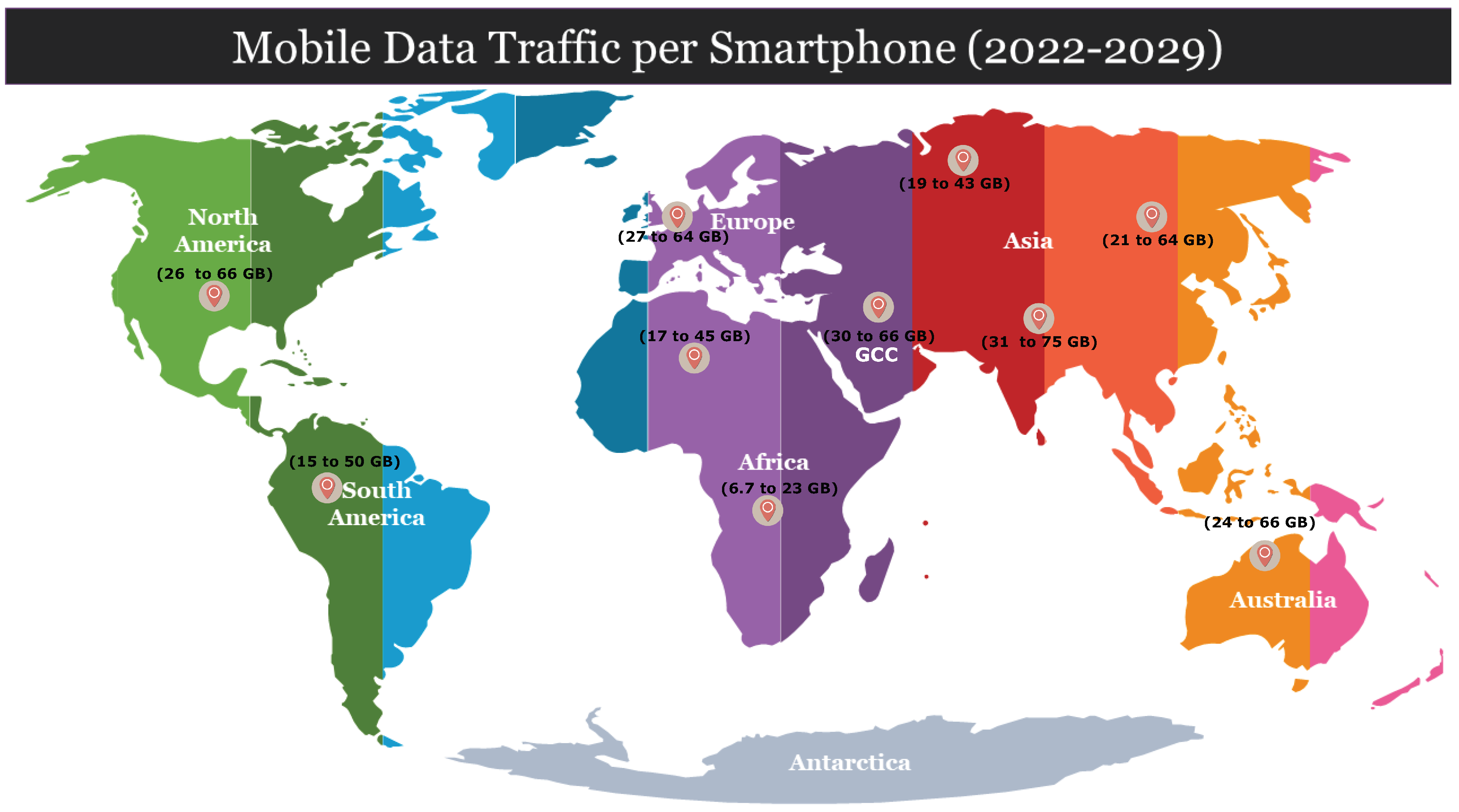


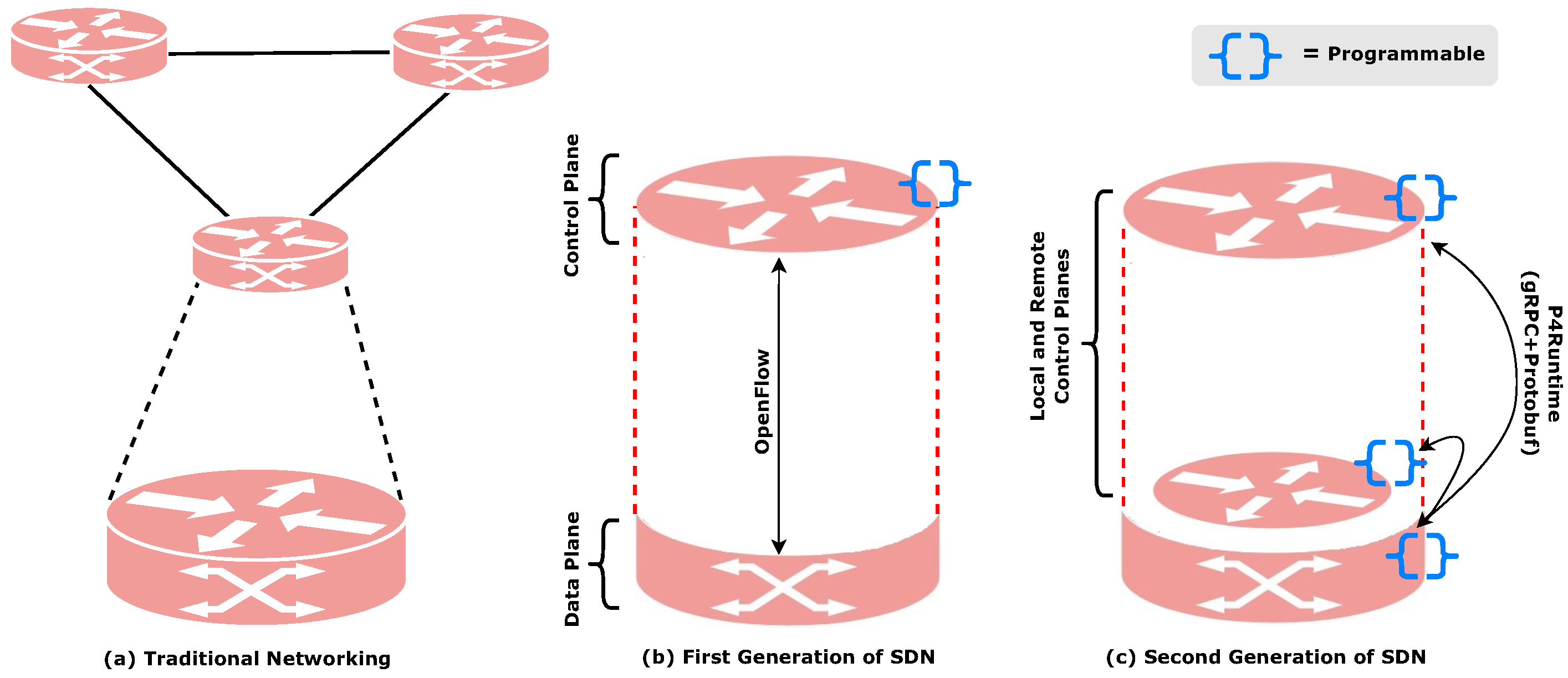

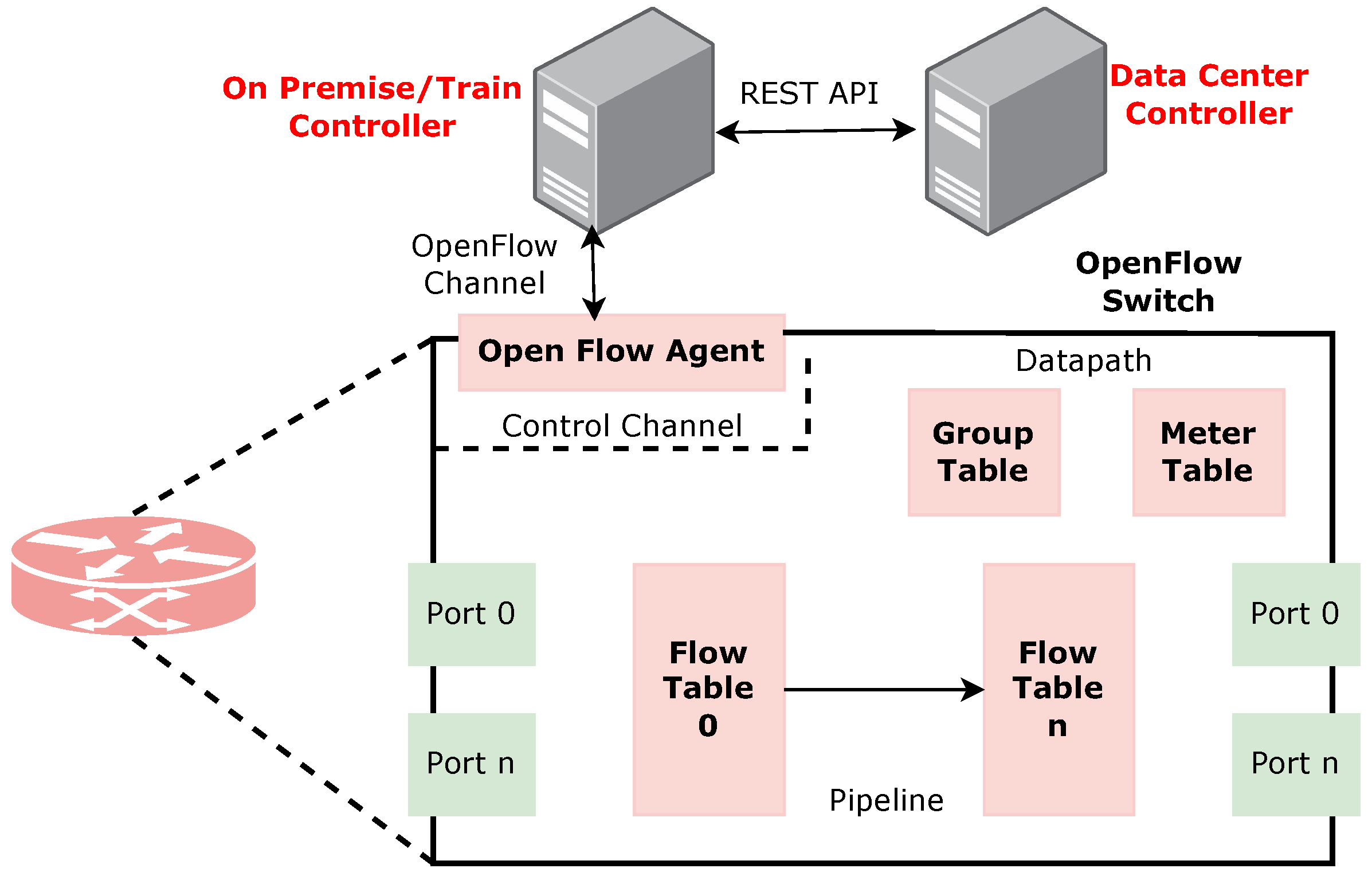

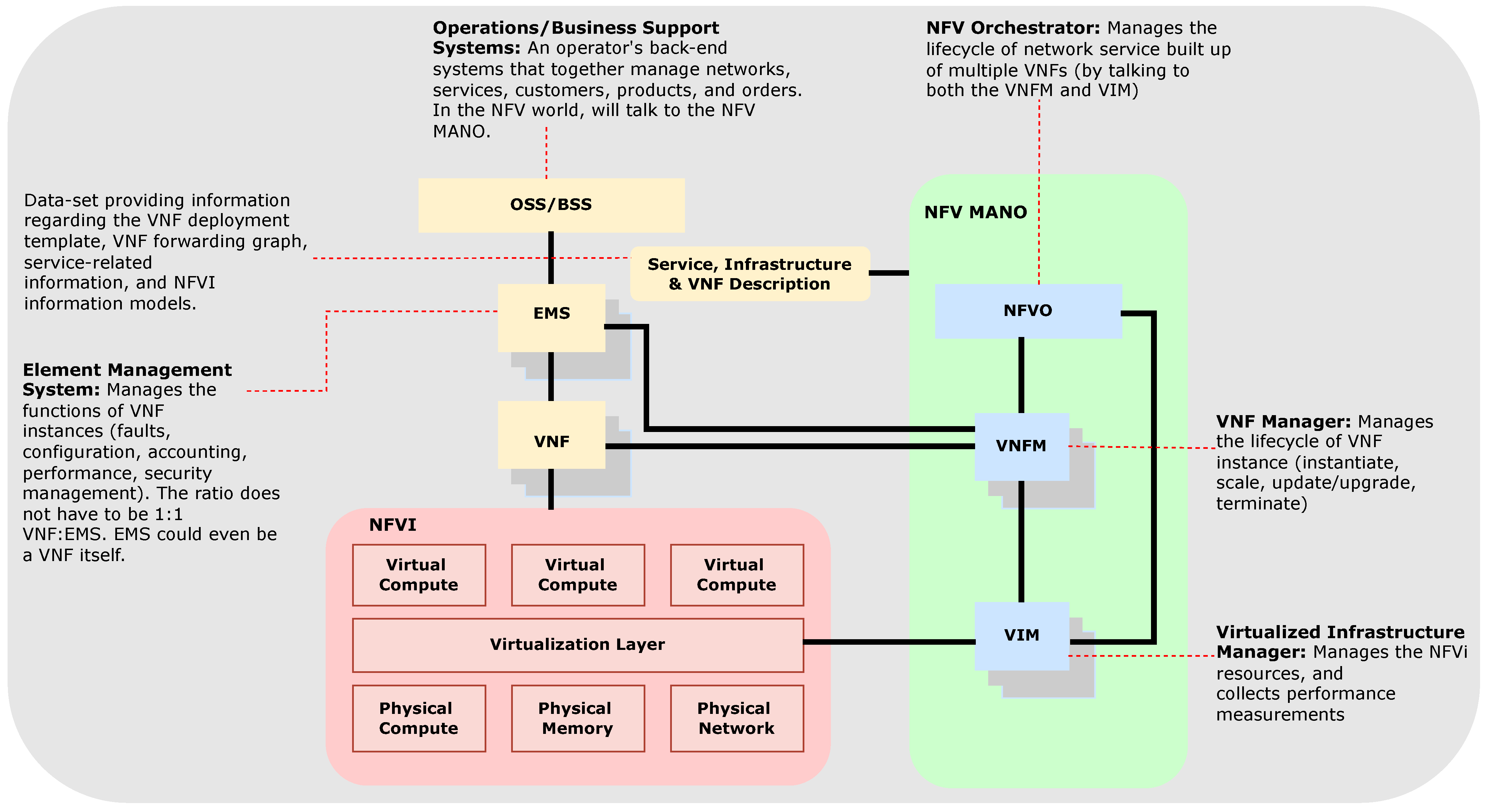
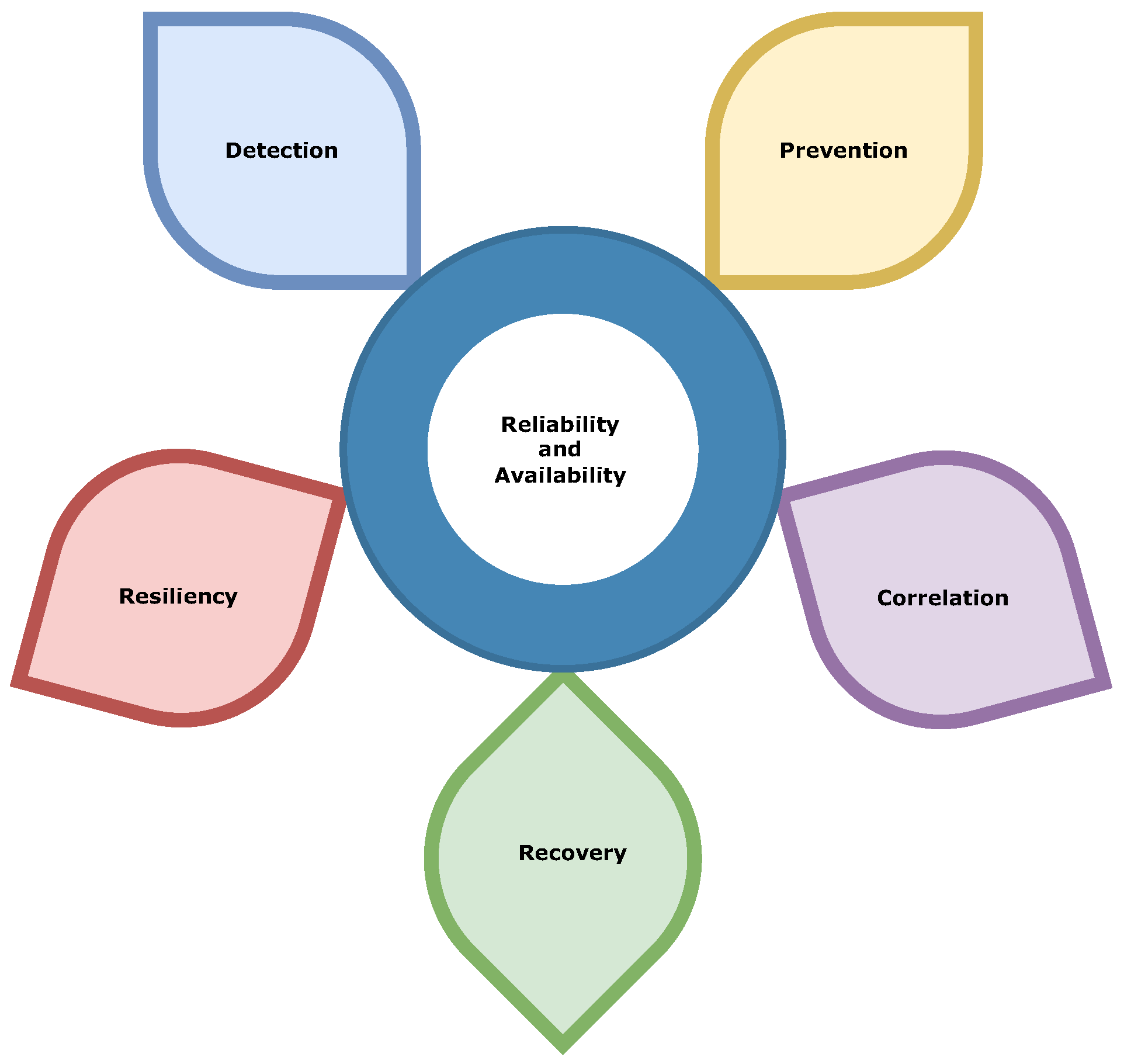

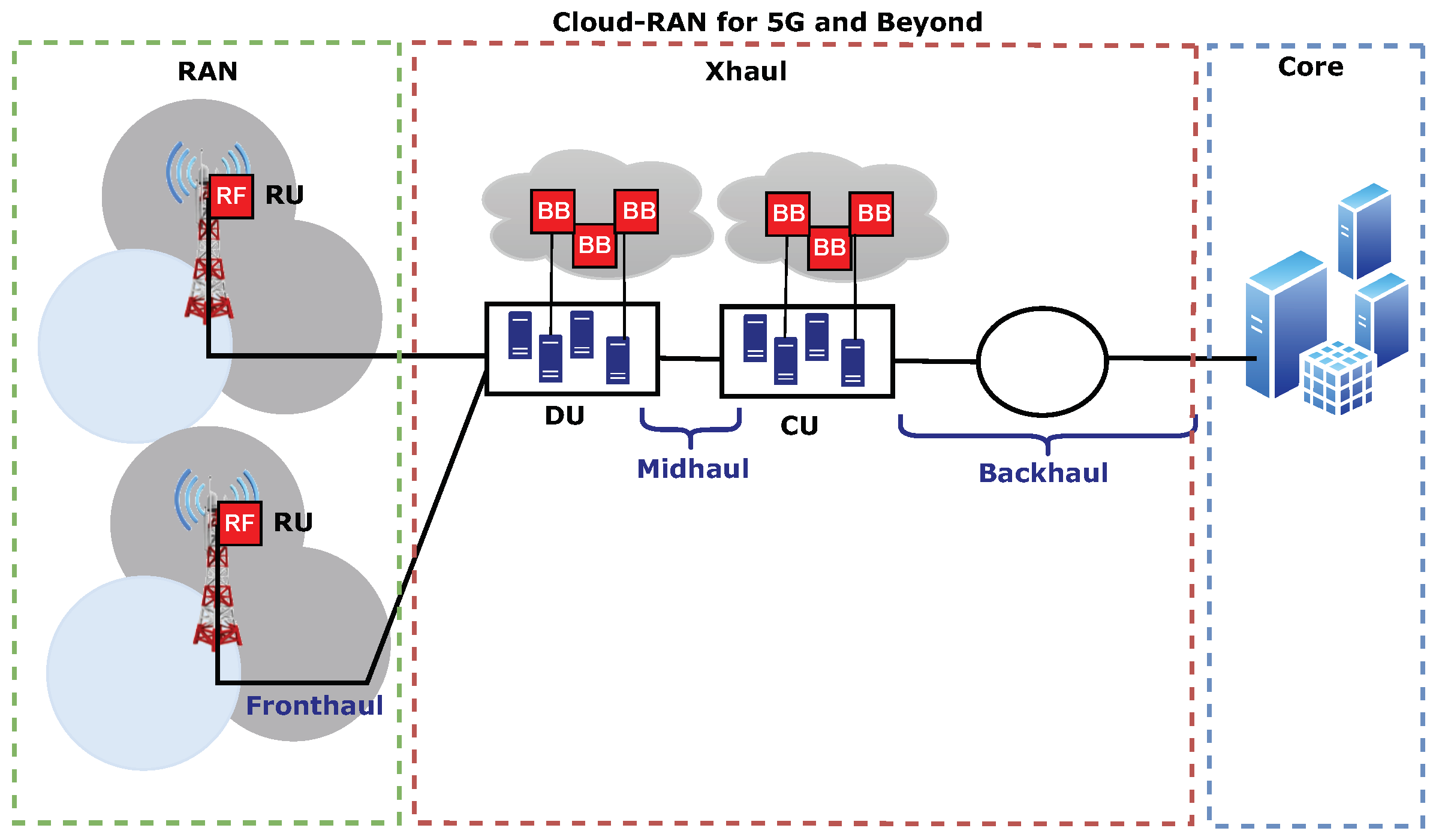
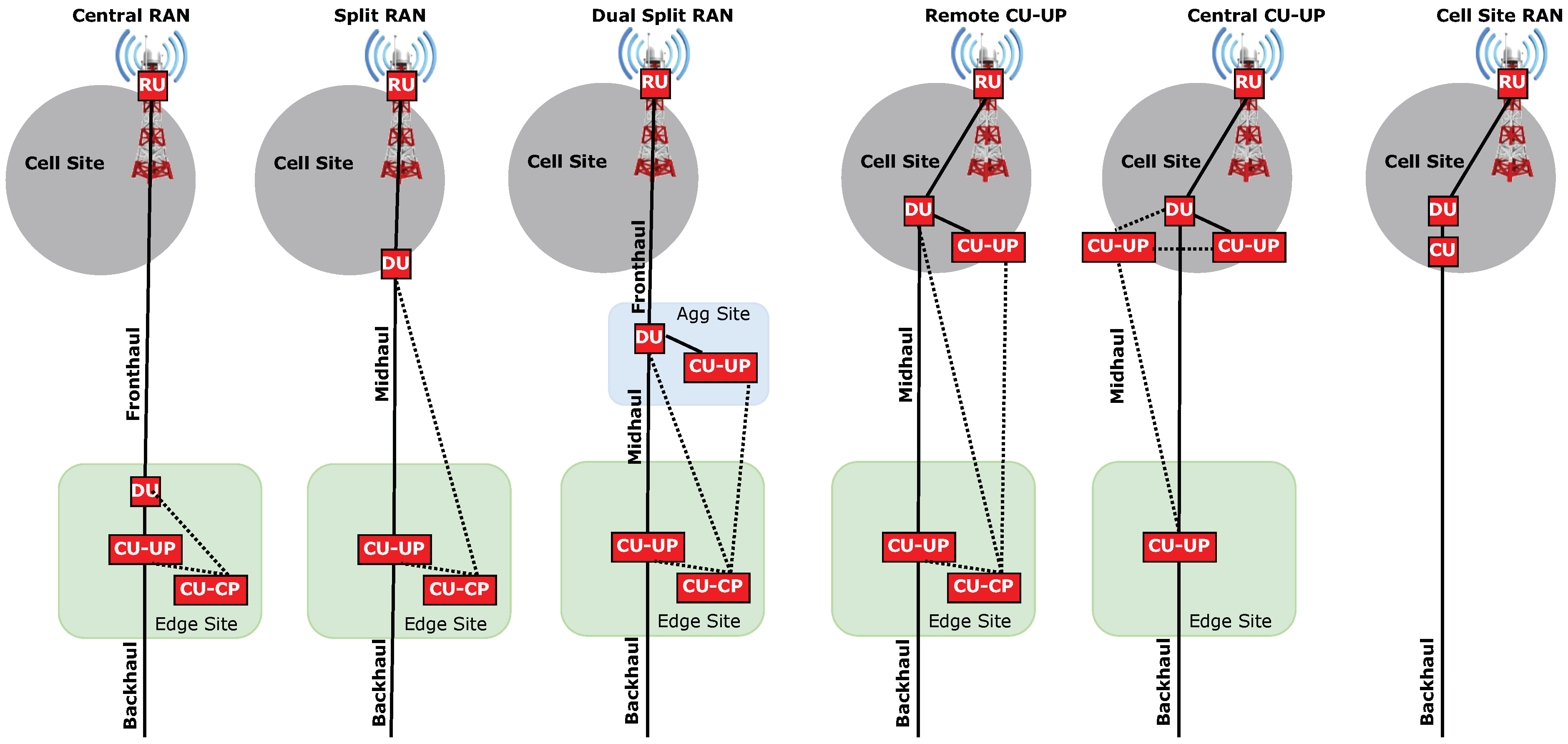
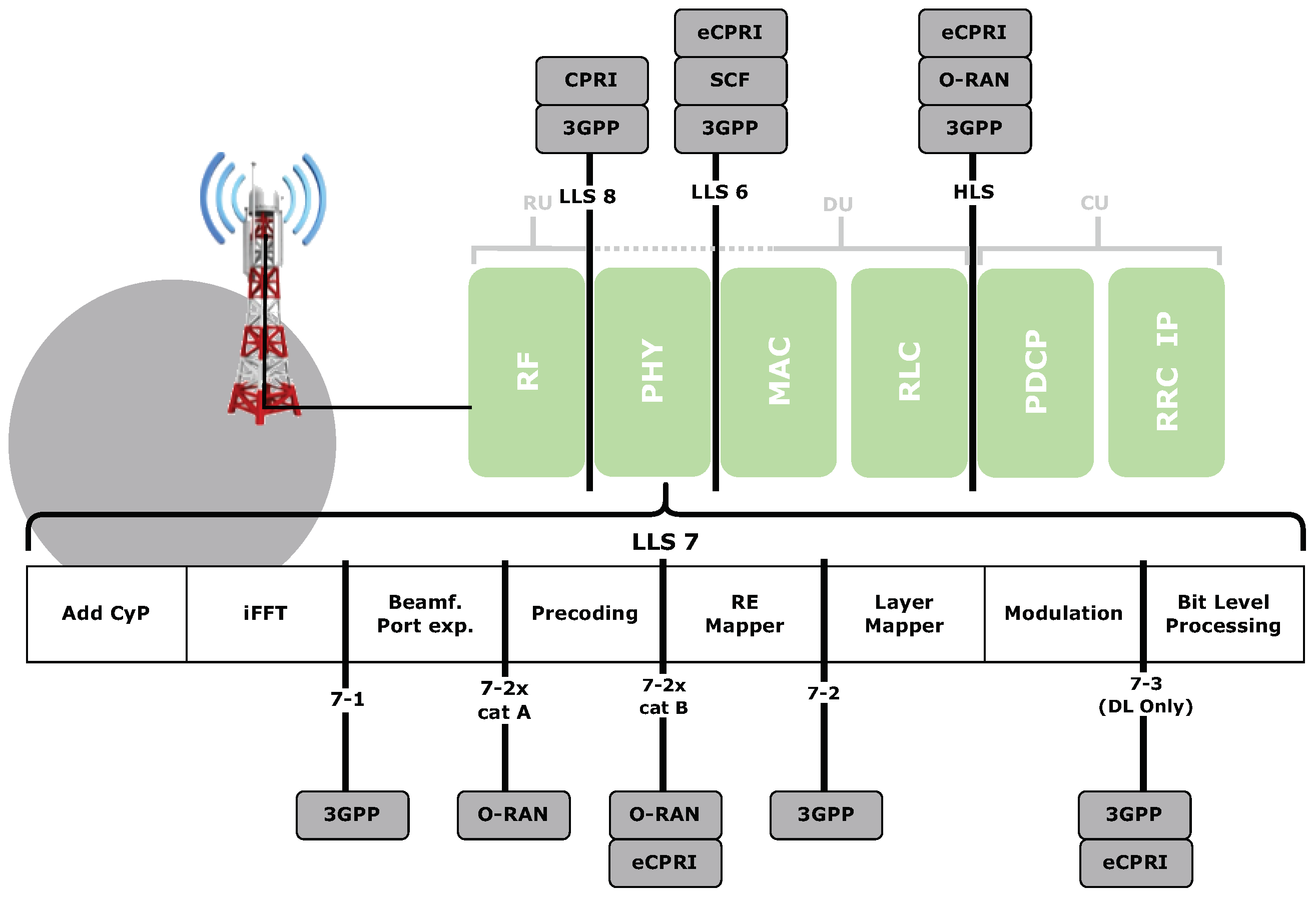


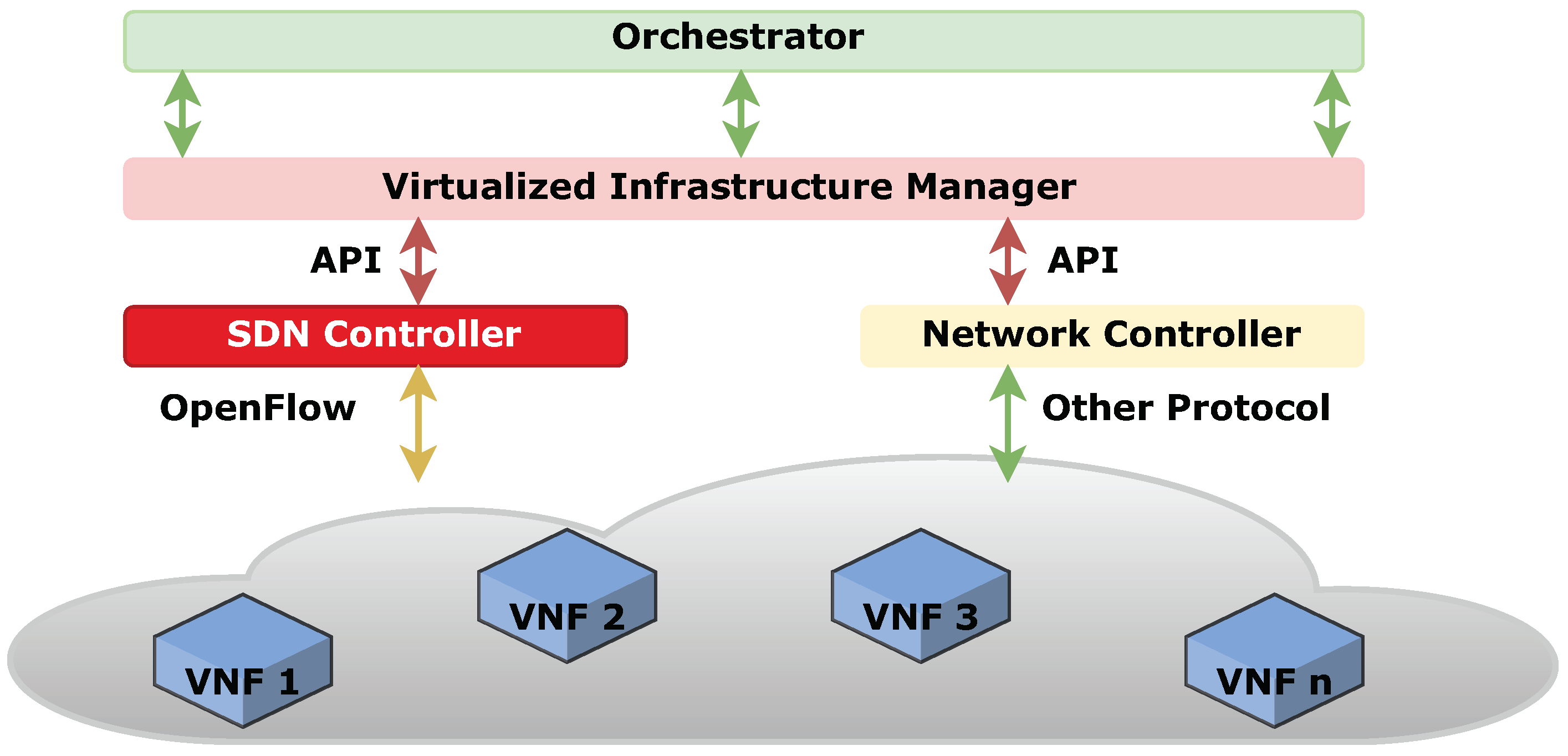
| Category | NFV | SDN |
|---|---|---|
| Concept | Abstracts network functions from conventional devices and encapsulates them as software. | Separates the forwarding plane from the control plane to enable automated and programmable network control. |
| Goal | Service providers propose replacing distributed network devices with consolidated ones. | To achieve network hardware devices’ programmability and centralized management and control. |
| Key Aspects | 1. Established procedure. 2. Hardware-based forwarding functions are detached from dedicated hardware. | 1. An open and programmable control plane 2. Hardware-based traffic forwarding, and decision-making within the control plane. |
| Conflict or Not | The fusion of NFV and SDN introduces a novel network model. NFV enables adaptable service orchestration, while SDN realizes unified management and configuration of network functions. |
| Category | NFV | Proprietary Network Equipment/Devices |
|---|---|---|
| Hardware Used | Generic x86-based servers, versatile storage devices, and adaptable switching equipment are utilized. | Dedicated devices are used. |
| Hardware-Software Separation | Software is separated from hardware and provided as module components. | Hardware and software are closely integrated, with software functions relying on dedicated hardware. |
| Receptiveness | Universal hardware foundation and standardized interfaces enable an open ecosystem through collaboration among multiple parties. | Relying on dedicated services results in a closed system, making it challenging to onboard third-party partners. |
| Network Resilience | General-purpose hardware and resource virtualization technologies enable dynamic adjustments of both software and hardware resources to meet specific service demands. | Dedicated devices do not align with virtualization technologies, hindering resource-sharing and flexible scaling capabilities. |
| Upgradation | Device upgrades occur swiftly, primarily involving software enhancements. | Deployment of network devices is time-consuming, necessitating both software and hardware provisioning. |
| Operation and Management | Virtualizes hardware resources and automates operations and management intelligently. | Upgrading and replacing devices is a complex process, as maintenance involves manual or semi-manual preparations and configurations through the CLI or web-based systems. |
| Service Organizations | NFV networks are deployed according to service requirements and can be dynamically orchestrated with flexibility. | Traditional networks operate with relative independence. Converting service requirements into network specifications is not swift, resulting in a sluggish network response. |
| Category | Centralized RAN | Virtualized RAN | Cloud RAN |
|---|---|---|---|
| Concept | Baseband processing is moved away from the cell sites to a central baseband pool. | Baseband processing is virtualized, running as software instances independently from the underlying hardware. | Virtualized baseband processing is centralized in a datacenter. Deployment options are agile. |
| Benefits | Reduced site footprint, improved cell cooperation, and shared cooling mechanisms. | Load balancing, agile service deployment, faster updates. | In addition to the benefits derived from centralized and virtualized RAN, Cloud-RAN also benefits from dynamic capacity assignment, improved scalability, and increased resource utilization. |
| Drawbacks | Large capacity and latency requirements for the transport network connecting radio functions to centralized baseband processing (fronthaul network). | Complexity of virtualized functions and challenges in running time-critical RAN functions on COTS hardware. | Cloud-RAN faces the same drawbacks as virtualized RAN, but its agile deployment options can reduce fronthaul complexity seen in centralized RAN. |
| Architectural Component | Solved Challenge | Technical Approach | Validation |
|---|---|---|---|
| Cellular Architecture with SDN Controller | Dynamic QoS Provisioning | OpenFlow/P4Runtime Programmability | Google’s SDN Deployment [65] |
| Virtualized Core Functions | Hardware Dependency | NFV MANO Lifecycle Management | 38% Energy Savings in 5G Cores [93] |
| BBU Pool with PHY/MAC Split | Fronthaul Capacity vs. Latency Tradeoff | O-RAN/C-RAN | Mavenir’s Open vRAN [143] |
| NFV-Managed RRUs | RAN Virtualization Overhead | In-line Acceleration for L1 Processing | Samsung’s 22% DU Power Reduction [143] |
| SDN-NFVO Integration | Multi-Vendor Interoperability | Standardized ETSI Interfaces | OPNFV Testbed Results [101] |
| Hierarchical Resource Pool | Energy-Inefficient Resource Fragmentation | Dynamic VNF Scaling Plus C-RAN Load Balancing | 83% BBU Energy Savings [128] |
Disclaimer/Publisher’s Note: The statements, opinions and data contained in all publications are solely those of the individual author(s) and contributor(s) and not of MDPI and/or the editor(s). MDPI and/or the editor(s) disclaim responsibility for any injury to people or property resulting from any ideas, methods, instructions or products referred to in the content. |
© 2025 by the authors. Licensee MDPI, Basel, Switzerland. This article is an open access article distributed under the terms and conditions of the Creative Commons Attribution (CC BY) license (https://creativecommons.org/licenses/by/4.0/).
Share and Cite
Singh, R.; Larsen, L.M.P.; Ollora Zaballa, E.; Berger, M.S.; Kloch, C.; Dittmann, L. Enabling Green Cellular Networks: A Review and Proposal Leveraging Software-Defined Networking, Network Function Virtualization, and Cloud-Radio Access Network. Future Internet 2025, 17, 161. https://doi.org/10.3390/fi17040161
Singh R, Larsen LMP, Ollora Zaballa E, Berger MS, Kloch C, Dittmann L. Enabling Green Cellular Networks: A Review and Proposal Leveraging Software-Defined Networking, Network Function Virtualization, and Cloud-Radio Access Network. Future Internet. 2025; 17(4):161. https://doi.org/10.3390/fi17040161
Chicago/Turabian StyleSingh, Radheshyam, Line M. P. Larsen, Eder Ollora Zaballa, Michael Stübert Berger, Christian Kloch, and Lars Dittmann. 2025. "Enabling Green Cellular Networks: A Review and Proposal Leveraging Software-Defined Networking, Network Function Virtualization, and Cloud-Radio Access Network" Future Internet 17, no. 4: 161. https://doi.org/10.3390/fi17040161
APA StyleSingh, R., Larsen, L. M. P., Ollora Zaballa, E., Berger, M. S., Kloch, C., & Dittmann, L. (2025). Enabling Green Cellular Networks: A Review and Proposal Leveraging Software-Defined Networking, Network Function Virtualization, and Cloud-Radio Access Network. Future Internet, 17(4), 161. https://doi.org/10.3390/fi17040161





